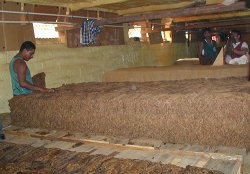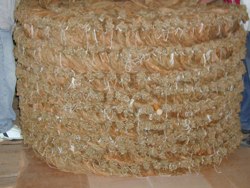FERMENTATION
Fermentation is the natural organic process that accounts for the majority of change and distinction in cigar tobaccos. Fermentation or "working" (trabajando) the tobacco is like a natural slow "cooking" process whereby the tobacco heats up under the pressure of its own weight. Carefully controlling the temperature cycles and tobacco humidity allows the tobacco to slowly expel (or sweat out) the ammonia and impurities in the leaves. This process develops the organoleptic qualities of the tobacco leaf. Unlike alcohol fermentation, tobacco fermentation does not produce any new "side effects"; rather, it purifies the leaf and allows the taste+aroma characteristics to develop.
Due to the unpredictability of the raw material, there is no purely scientific way to control fermentation and achieve a desired “taste” or specific result. Fermentation is part art, science, and a natural wonder. Anyone who has ever seen or smelled “raw” tobacco knows that it is unpalatable: fermentation is where the artistry of the cigar maker will be tested the most.
The following sections use a 2 (to 3) stage model to illustrate some of the nuances and techniques for fermentation. Fermentation is more art than science, so keep in mind this is only a general outline of the process.
1st FERMENTATION
 Leaves can be bunched together in gavillas, which are bunches of 5 or more leaves, and laid in short piles (1 to 3 feet tall) called pilones. If the temperature exceeds 35°C/95°F the pilones are unraveled and the gavillas are shaken out and cooled. New pilones are made and the fermentation continues for approximately 30 days. The 1st fermentation gives the leaves a more uniform color and begins the process of detoxification. Leaves can be bunched together in gavillas, which are bunches of 5 or more leaves, and laid in short piles (1 to 3 feet tall) called pilones. If the temperature exceeds 35°C/95°F the pilones are unraveled and the gavillas are shaken out and cooled. New pilones are made and the fermentation continues for approximately 30 days. The 1st fermentation gives the leaves a more uniform color and begins the process of detoxification.
*After the 1st fermentation, the leaves are sorted and classified according to color, texture, and type of leaf: wrappers, binders, fillers.
*Before fermentation, filler and binder leaves have the thickest part of their stem removed (the bottom half), and may be moistened with a mixture of water and tobacco stems and residues betun) to accelerate the fermentation: a process called enbetunando.
2nd FERMENTATION
 The leaves, now reclassified and re-humidified, are formed into giant (4 to 6 foot tall) burros. The burro's mass (thousands of pounds) and the reintroduced water, ignite the next round of fermentation. The second fermentation is much more intense and lasts about 60 days (or longer). This fermentation has the most dramatic impact on the flavor and aroma of the final cigar. Anyone who has ever entered a fermentation room knows the air is filled with overpowering ammonia being released by the leaves. The leaves, now reclassified and re-humidified, are formed into giant (4 to 6 foot tall) burros. The burro's mass (thousands of pounds) and the reintroduced water, ignite the next round of fermentation. The second fermentation is much more intense and lasts about 60 days (or longer). This fermentation has the most dramatic impact on the flavor and aroma of the final cigar. Anyone who has ever entered a fermentation room knows the air is filled with overpowering ammonia being released by the leaves.
The length of fermentation will vary for different leaf types. Ligero, the most robust and dense leaf of the Criollo plant, will take the longest to process, while seco and volado will take less.
Great care must be taken not to “burn out” the tobacco by letting the center's temperature exceed (approximately) between 108 - 140°F. When the temperature reaches this critical point, the burros are systematically unraveled and re-distributed.
3rd FERMENTATION

Originally, the 'legendary' Cohiba brand was the only Cuban cigar to undergo a 3rd fermentation. This fermentation took place in barrels at lower than usual temperatures. The result of the 3rd fermentation gave the Cohiba a richer and more nuanced flavor profile.
The concept of a 3rd fermentation may simply be a marketing concept which makes that product seem more special. As we have learned, "over-fermentation" will exhaust the tobacco of its organoleptic properties: too much fermentation will ruin tobacco leaf. Perhaps the concept of a 3rd fermentation is really another period of añejamiento, or slow aging.
Fermentation: More Art Than Science
In reality, almost every individual cigar maker has their own recipe for fermentation(s). Cigar makers can vary the size and layout of their fermentation piles as well as the internal temperatures and length of fermentations. Adding to the complexities, the number and length of fermentation will vary for every leaf that goes into a cigar. In addition to blending leaves from different parts of the plant (each requiring specialized attention), most cigars are a complex blend of leaves from different farms and countries. While it can be overwhelmingly complex to manage this process for one cigar, a great brand must be replicated with consistency, year after year. The art, science, & magic of fermentation is not something that can be learned from a book or conveyed in words: it must be experienced over many years and with every sense. |
Certified R&D Tobacconists: United States |
|
|
|
|
|

